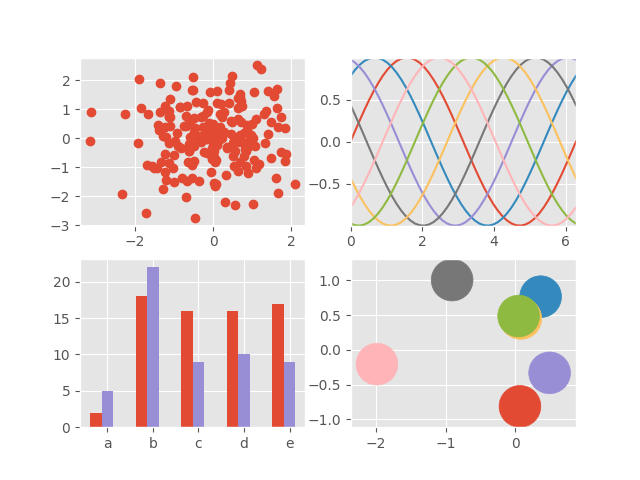Note
Go to the end to download the full example code.
12.3.10.1.8. GGPlot#
This example demonstrates the ggplot style, which adjusts the style to
emulate ggplot (a popular plotting package for R).
These settings were shamelessly stolen from [1] (with permission).

import numpy as np
import matplotlib.pyplot as plt
plt.style.use("ggplot")
# Fixing random state for reproducibility
np.random.seed(19680801)
fig, axes = plt.subplots(ncols=2, nrows=2)
ax1, ax2, ax3, ax4 = axes.ravel()
# scatter plot (Note: `plt.scatter` doesn't use default colors)
x, y = np.random.normal(size=(2, 200))
ax1.plot(x, y, "o")
# sinusoidal lines with colors from default color cycle
L = 2 * np.pi
x = np.linspace(0, L)
ncolors = len(plt.rcParams["axes.prop_cycle"])
shift = np.linspace(0, L, ncolors, endpoint=False)
for s in shift:
ax2.plot(x, np.sin(x + s), "-")
ax2.margins(0)
# bar graphs
x = np.arange(5)
y1, y2 = np.random.randint(1, 25, size=(2, 5))
width = 0.25
ax3.bar(x, y1, width)
ax3.bar(
x + width,
y2,
width,
color=list(plt.rcParams["axes.prop_cycle"])[2]["color"],
)
ax3.set_xticks(x + width)
ax3.set_xticklabels(["a", "b", "c", "d", "e"])
# circles with colors from default color cycle
for i, color in enumerate(plt.rcParams["axes.prop_cycle"]):
xy = np.random.normal(size=2)
ax4.add_patch(plt.Circle(xy, radius=0.3, color=color["color"]))
ax4.axis("equal")
ax4.margins(0)
plt.show()
Total running time of the script: (0 minutes 0.103 seconds)
